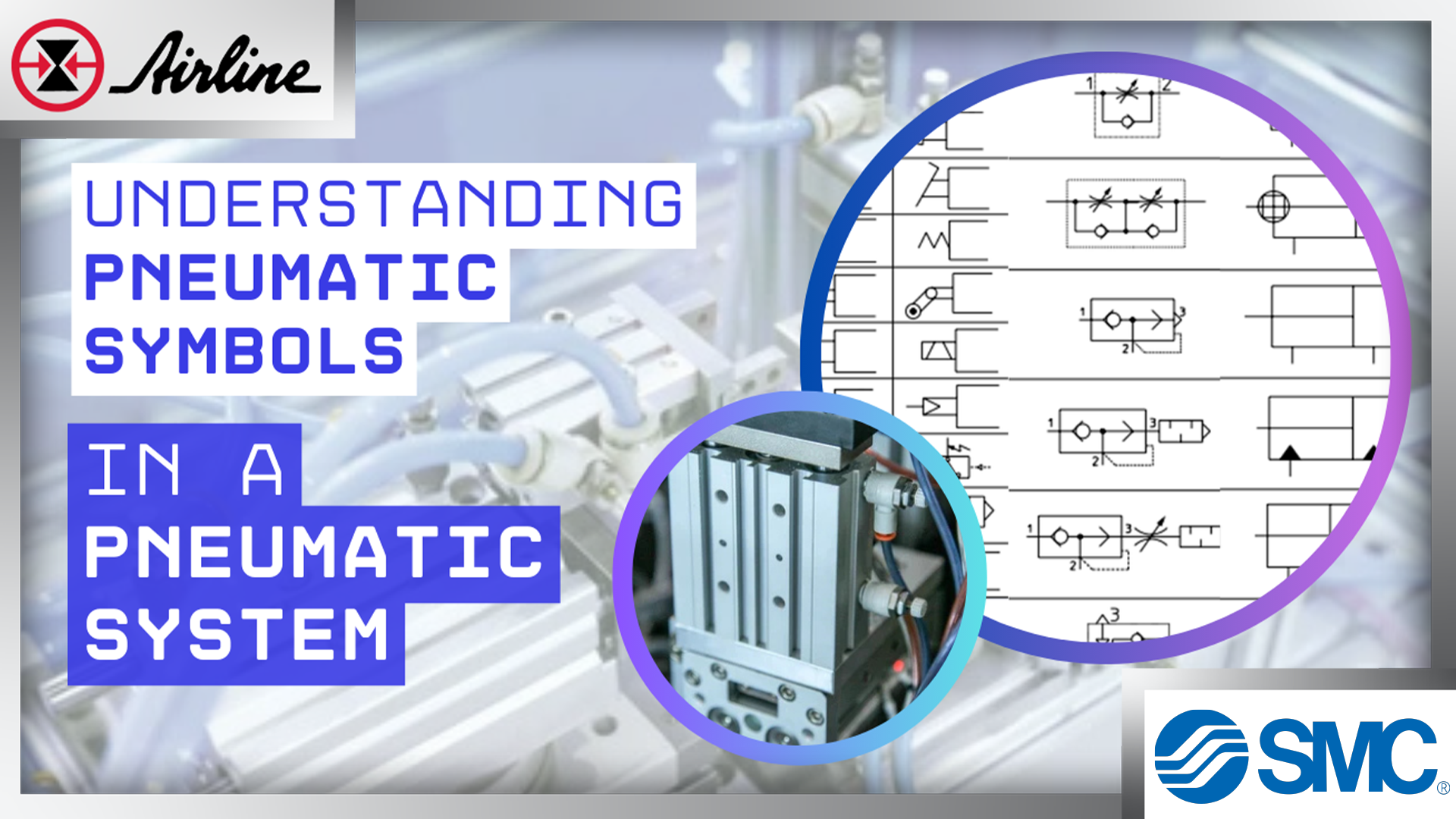Ever looked at a pneumatic schematic and felt like you were trying to crack a secret code? You’re not alone.
Pneumatic symbols can seem overwhelming at first, but once you get the hang of them, they become an essential tool for understanding, designing, and troubleshooting compressed air systems.
This post isn’t about what a pneumatic system is—that’s covered elsewhere. Instead, we’re diving into the visual language behind it all: the symbols. You’ll learn how to recognize common components, read a basic schematic, and access a bookmarkable chart you can keep on hand. Let’s get started.
Skip to a Section
What Are Pneumatic Symbols | Common Pneumatic Symbols You Should Know |
What’s Next? | Additional Resources
💡 Download your FREE pneumatic symbols chart today!
What Are Pneumatic Symbols (And Why They Matter)
|
Simplified Block Diagram for Educational Use Only |
Think of pneumatic symbols as the visual language of compressed air systems. Instead of spelling out every part—like a valve, actuator, or filter—we use simple, standardized shapes to represent them. These symbols help engineers and technicians quickly understand how a system is constructed and how it functions, without requiring lengthy explanations.
The beauty of pneumatic symbols is that they transcend language barriers. Whether you're working with a local team or collaborating with engineers across the globe, these standardized symbols keep everyone on the same page. You don’t need to speak the same language to read the same schematic.
Most pneumatic symbols follow ISO standards (like ISO 1219), which means they're recognized and understood worldwide. That consistency reduces design errors, speeds up maintenance, and helps avoid costly mistakes. When your diagrams use the right symbols, it’s easier for others to troubleshoot, make changes, or build upon your work without confusion.
Whether you're designing a new system or diagnosing an existing one, having a firm grasp of pneumatic symbols isn’t just helpful—it’s essential.
Here’s Why it Matters:
Faster troubleshooting – When a machine goes down, the schematic is your roadmap. If you can read it, you can fix the issue faster.
Fewer design mistakes – Standardized symbols reduce the risk of miscommunication during planning and documentation.
Better collaboration – Everyone on your team (and even across vendors or facilities) stays on the same page.
More confident decision-making – When you understand what’s happening in the system, you can make smarter, faster choices.
Bottom line: Pneumatic symbols help you work smarter, not harder—and mastering them is a skill that pays off.
Common Pneumatic Symbols You Should Know
Once you start recognizing pneumatic symbols, reading a schematic becomes a whole lot easier. Whether you’re troubleshooting a circuit or designing a new system, knowing what each shape and arrow means is key to understanding how compressed air flows through your equipment.
Let’s break down the most common types of symbols you’ll see—and what they actually mean.
Directional Control Valves (Valve Schematics)
Directional control valves are the backbone of most pneumatic circuits. Their symbols often look like stacked boxes with arrows and lines. Here's what they represent:
Flow boxes: Each box = one valve position
Arrows: Show the direction of airflow
Actuators: Indicate how the valve is operated (manual, electric, pneumatic)
Ports: The numbered connection points for airflow
| Directional Control Valves |
 |
| Directional control valve, 2/2-way valve, closed normal position. |
Flow Control Valves
Flow control valves manage actuator speed and motion control by regulating airflow. Their symbols often include:
A slashing arrow across a passage or line, which indicates that the orifice is adjustable—this is what controls the airflow rate.
A check valve symbol, which allows flow in one direction while restricting it in the other.
When these two features are combined—an adjustable orifice and a check valve—you get a classic flow control valve. This setup enables precise control in one direction (like during extension) while allowing free return flow (like retraction), which is key in many automation setups.
| Flow Control Valves |
.png?width=166&height=211&name=unnamed%20(12).png) |
| Flow control valve symbol: shows an adjustable orifice (slashing arrow) and check valve combination for directional speed control. |
Actuators & Cylinders
Actuators perform the movement in your pneumatic system. Their symbols use rectangles and arrows to show type and motion. There’s one more detail to look for:
.png?width=202&height=135&name=unnamed%20(13).png) A slashing arrow across the piston indicates an adjustable cushion. This feature slows the piston as it reaches the end of its stroke to reduce impact—especially useful in high-speed or heavy-load applications.
A slashing arrow across the piston indicates an adjustable cushion. This feature slows the piston as it reaches the end of its stroke to reduce impact—especially useful in high-speed or heavy-load applications.
Here's what else to look for:
Single-acting cylinders: Air moves the piston in one direction, and a spring or external force returns it.
Double-acting cylinders: Air powers both extension and retraction.
| Single-Acting | Double-Acting |
|
|

|
| Single-acting cylinder, single piston rod, return stroke by spring | Double-acting cylinder, single-piston rod |
Air Preparation Units (FRLs)
Clean, dry air keeps your system healthy. Look for these FRL symbols:
Filter: Removes particles and moisture (symbol may include a mesh or bowl)
Regulator: Controls pressure (often a spring/diaphragm symbol)
Lubricator: Adds oil mist (look for a droplet symbol)
These are typically placed near the compressor and often grouped together in diagrams.
|
Air Preparation Units |
 |
| Air combination, Air filter, regulator, and Lubrication |
Ports and Flow Paths (Arrows & Boxes)
Every pneumatic component includes ports—your connection points. In schematics, they’re usually shown as:
Circles or open ends with numbered labels (e.g., Port 1 = supply, Port 2 = output)
Arrows indicate flow direction
T-shaped lines show closed ports with no flow
Getting familiar with flow paths makes it much easier to troubleshoot and modify circuits.
| Ports and Flow Paths |
 |
| One way flow control valve, adjustable |
Pro Tip: Study real-world diagrams and use our downloadable chart to get comfortable identifying these symbols quickly.
What’s Next?
This is just the beginning. Download our free reference guide for ISO and JIS-compliant pneumatic symbols—perfect for engineers, technicians, and anyone working with compressed air systems. Or, need help selecting components? Talk to a pneumatic expert today.
Coming soon:
Now that you’ve got a handle on common pneumatic symbols subscribe to our blog so you don’t miss the next posts in the series:
- How to Read a Pneumatic Diagram (Step-by-Step)
- Troubleshooting Pneumatic Circuits Like a Pro
In the meantime, explore our other pneumatic blog posts.
Additional Resources
Download Now: Free Pneumatic Symbols Guide
Download Now: SMC Survival Guide – A complete toolkit with charts, formulas, and more.
Need help selecting components? Talk to a pneumatic expert.











Leave Comment